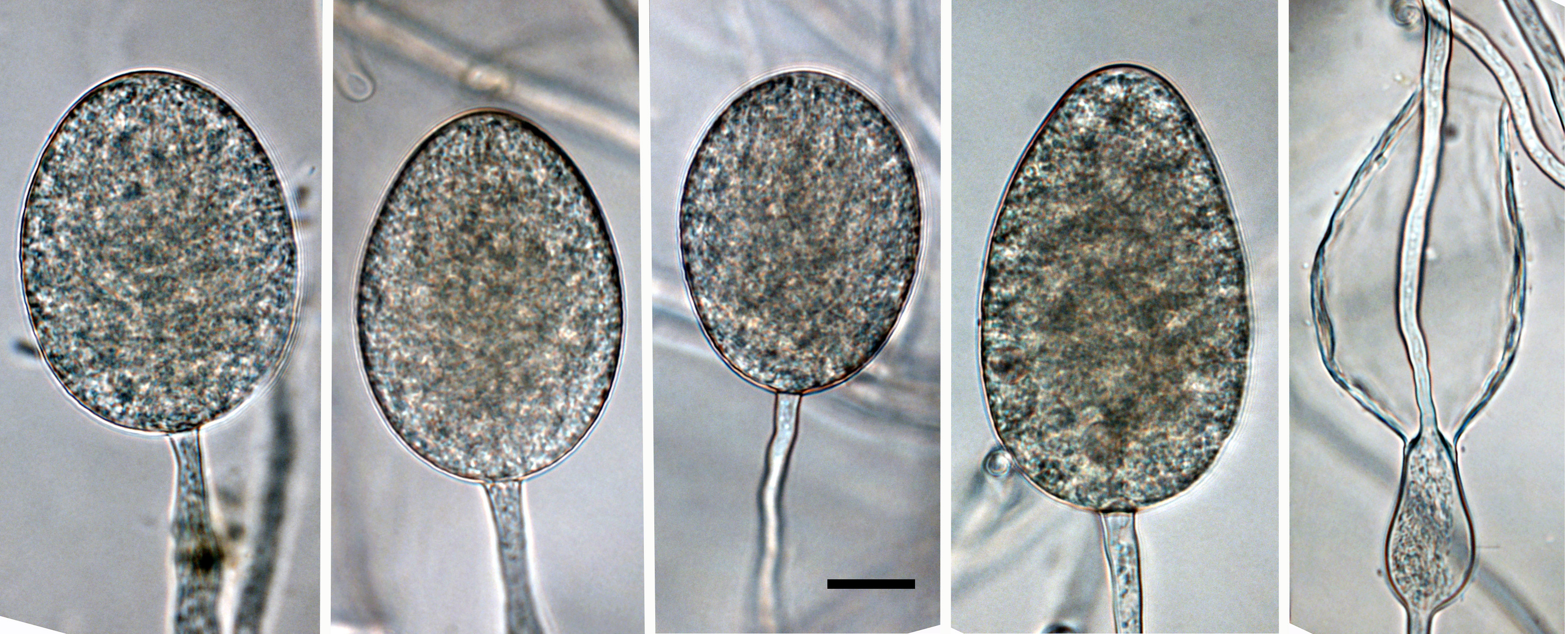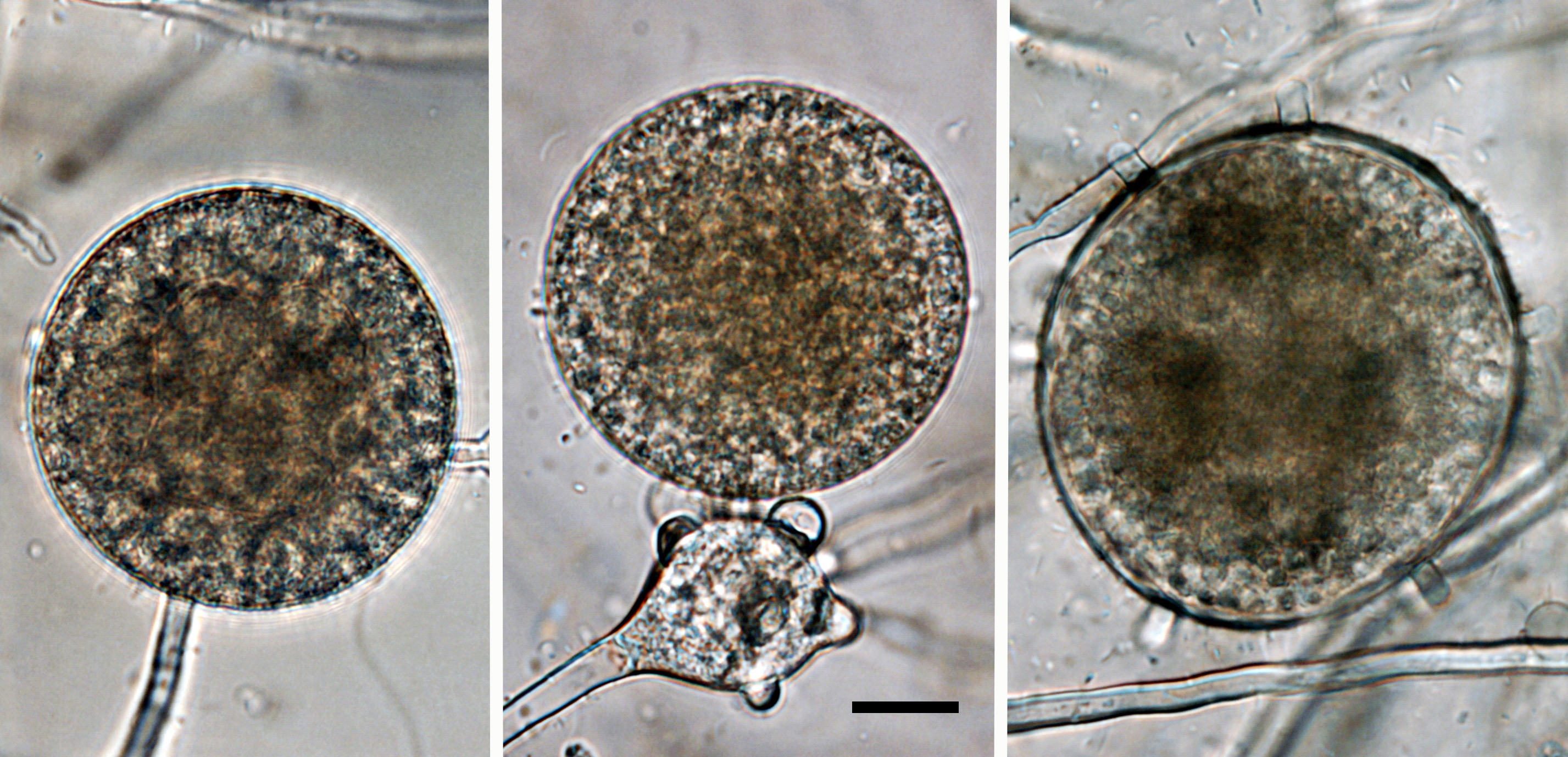Phytophthora personensis
|
Phytophthora spp. in subclade 6a: portion of the seven-loci ML phylogeny featuring the type cultures of 212 described species (by T. Bourret). Notice the position of P. personensis Ex-type CBS 146549. Gloria Abad, USDA S&T.
|
|
Phytophthora spp. in subclade 6a: Morphological Tabular key (PDF) and Tabular key legends (PDF) in IDphy2 KEY SECTION. Notice the data of P. personensis Ex-type CBS 146549. Gloria Abad, USDA S&T.
|
|
colony morphology after 5 d growth at 20ºC on CA, MEA, PDA, and V8A (from left to right) |
|
persistent, non-papillate, predominantly ovoid sporangia; scale bar = 20µm |
|
large chlamydospores common; scale bar = 20µm |
Name and publication
Phytophthora personensis Abad, W. Gut. & T.I. Burgess (2020)
Burgess TI and Abad ZA. 2020. Phytophthora personensis. Fungal Planet 1104. Persoonia 44: 141 in Crous et al. Fungal Planet description sheets 1042–1111. Persoonia 44: 301-459.
Nomenclature
Mycobank
Etymology
named after Person County, North Carolina, the location where the first specimen of the species was isolated
Typification
Type: Australia, Western Australia, Busselton, baited from soil associated with dying Grevillea mccutcheonii (Myrtaceae), 2005, holotype MURU481
Ex-type: culture CBS 146549 = VHS14081
Sequences of ex-type in manuscript: ITS EU301169, β-tubulin MF326805, HSP90 MF326890, coxI MF326887, nadh1 MF326928, LSU MT159417
Ex-type in other collections
(ET) CBS 146549, VHS14081
Molecular identification
Voucher sequences for barcoding genes (ITS rDNA and COI) of the ex-type (see Molecular protocols page)
Phytophthora personensis ITS rDNA, COI
Voucher sequences for Molecular Toolbox with seven genes (ITS, β-tub, COI, EF1α, HSP90, L10, and YPT1
(see Molecular protocols page) (In Progress)
Voucher sequences for Metabarcoding High-throughput Sequencing (HTS) Technologies [Molecular Operational Taxonomic Unit (MOTU)]
(see Molecular protocols page) (In Progress)
Sequences with multiple genes for ex-type in other sources
- NCBI: Phytophthora personensis
- EPPO-Q-bank: Phytophthora personensis
- BOLDSYSTEMS: Phytophthora personensis
Position in multigenic phylogeny with 7 genes (ITS, β-tub, COI, EF1α, HSP90, L10, and YPT1)
Clade clade:
a taxonomic group of organisms classified together on the basis of homologous features traced to a common ancestor
6a
Morphological identification
Colonies and cardinal temperatures
Colony colony:
assemblage of hyphae which usually develops form a single source and grows in a coordinated way
morphology on all media was submerged and uniform except for PDA which produced cottony colonies. Minimum growth temperature 4°C, optimum 27.5°C, and maximum 37.5°C.
Conditions for growth and sporulation
SporangiaSporangia:
sac within which zoospores form, especially when water is cooled to about 10°C below ambient temperature; in solid substrates, sporangia usually germinate by germ tubes
are produced in water cultures (soil extract) and not observed in solid media. OogoniaOogonia:
the female gametangium in which the oospore forms after fertilization by the antheridium
were not formed even when paired with different mating types.
Asexual phase
SporangiaSporangia:
sac within which zoospores form, especially when water is cooled to about 10°C below ambient temperature; in solid substrates, sporangia usually germinate by germ tubes
were non-papillate, persistentpersistent:
pertaining to sporangia that remain attached to the sporangiophore and do not separate or detach easily (cf. caducous)
, and predominantly ovoidovoid:
egg-shaped, with the widest part at the base of the sporangium and the narrow part at the apex
in shape with internal proliferationinternal proliferation:
internal proliferation occurs when the sporangiophore continues to grow through an empty sporangium
, both nested and extended. SporangiaSporangia:
sac within which zoospores form, especially when water is cooled to about 10°C below ambient temperature; in solid substrates, sporangia usually germinate by germ tubes
averaged 62.8 x 44.2 µm (overall range 28.5–85.6 x 15.1–60.5 µm). Sporangiophores simple. Hyphal swellings present. ChlamydosporesChlamydospores:
an asexual spore with a thickened inner wall that is delimited from the mycelium by a septum; may be terminal or intercalary, and survives for long periods in soil
present.
Sexual phase
Sterile in culture.
Most typical characters
Phytophthora personensis resides in cladeclade:
a taxonomic group of organisms classified together on the basis of homologous features traced to a common ancestor
6a and shares a common ancestor with P. inundata, P. condilina, P. humicola, P. balyanboodja, and P. chesapeakensis. All these species are morphologically similar. Sequences from Norway and Pakistan submitted to GenBank as P. inundata share 100% identity with P. personensis.
Additional specimen(s) evaluated
Australia, Western Australia, Busselton, baited from soil associated with dying Grevillea mccutcheonii , 2005, CBS146549 = VHS14081; Pemberton, baited from soil associated with dying Rubus fruticosus, 2012, S. Aghighi, SA278; Victoria, Ti-Tree Creek, baited from water, 2008, W. Dunstan, culture MUCC 767; USA, Northern Carolina, Person County, from necrotic roots of Nicotiana tabacum, 2002, W. Gutierrez, P11555 = CBS121980; P11491
Hosts and distribution
Distribution: Australia, USA
Substrate: roots
Disease note: Phytophthora root and collar rot of young seedlings
Hosts: Nicotiana tabacum, Rubus fruticosus, Grevillea mccutcheonii
Additional references and links
- SMML USDA-ARS: Phytophthora personensis
- EPPO Global Database: Phytophthora personensis
- Forest Phytophthoras of the world: Phytophthora personensis
- CABI Digital Library: Phytophthora personensis
- Encyclopedia of Life (EOL): Phytophthora personensis
- Index Fungorum (IF): Phytophthora personensis
Fact sheet author
Treena Burgess, Ph.D., Phytophthora Science and Management, Harry Butler Institute, Murdoch University, Australia
Z. Gloria Abad, Ph.D., USDA-APHIS-PPQ-S&T Plant Pathogen Confirmatory Diagnostics Laboratory (PPCDL), United States of America.




